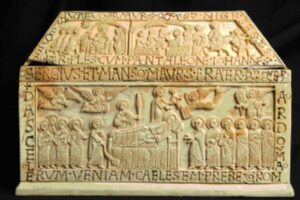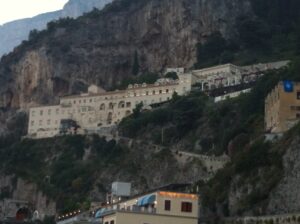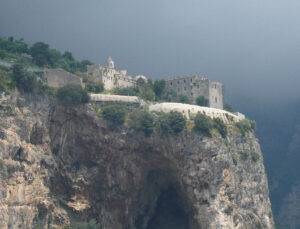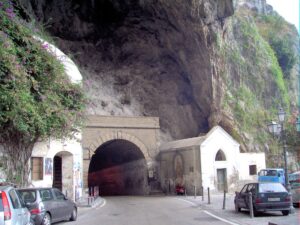MONASTERO SS. TRINITA’
“The Tamed Revolt”
The ancient Benedictine monastery of the Holy Trinity, dating back to the 10th century, unlike other ecclesiastical properties that were transferred in the early 1800s to state property, was, for the most part, destroyed at the imposition of a Royal Decree as revenge for the support given by the inhabitants to the nuns who refused to abandon it after its suppression. The area is placed in a strategic point both for the landscape aspect, favored by the high altitude in relation to the historic center, and for the proximity to well-known itineraries of great charm (Villa Rufolo – Villa Cimbrone).
On the Monastery of the Holy Trinity, abandoned in the early 19th century and now completely disappeared, there are no bibliographical news and certain documentary sources that allow the reconstruction of the original structure. The lack of historical iconography makes it impossible to obtain further information regarding the location of the monument itself within the town. Ravello, originally connected to the republic of Amalfi, constituted since the 10th century a place of residence for the patrician families of the Coast and was the site of numerous convent complexes; the Benedictine monastery of the Holy Trinity, founded in 944, exclusively housed young women from noble families endowed with dowries, gathering a considerable landed heritage. The only information that has reached us about it is due to Mansi (1887) who reports of an entrance for the cloistered nuns to the West – through a small vestibule – of a fairly large dormitory, capable of accommodating more than thirty nuns in the second half of the sixteenth century, and of a garden enclosed by high walls placed to the East. The church, of which no information is given regarding its orientation, is described as having a single nave with a choir and organ at the end, an elaborate roof on which are shown the arms of the Frezza family, three altars and four burials. The narthex or pronaos is an element historically present in many churches or religious complexes in the area (as in the church of San Francesco in Ravello), since has the characteristic of “blending” with the road leading to the convent, so that it constitutes a “public porch” of obligatory passage (Schiavo 1941). It usually opened the only door to the monastery or church. Covered with a barrel or cross vault, it was often connected by sub-arches to the internal division of the church, which consisted of three naves covered by vaults and separated by colonnades. Giuseppe Imperato (1981) in his text privileges, instead of the description of the convent, the organization of the cloistered order and the rules imposed on it. He writes, however, that the church was preceded by an atrium, the roof of which was supported by columns decorated in the same way as the Freccia Family, with the image of the Holy Trinity in the middle. And, as confirmed by the Pastoral Visit of Msgr. Guerriero in 1719, the monastery was also accessible through a vestibule, where there was a parlor with wooden gates. In the same Visit, it is reported that access to the church was through twenty-six factory steps, that to the right of the entrance was the sacristy, and above the door was the nuns’ choir. Imperato writes, without giving the source, that at the time of its abandonment in 1812, “there were still three lower and two upper rooms with a front loggia, adjacent to the church, that needed to be refitted, the roof was dismantled and the tiles re-used to fix the roof of the Duomo cathedral, and the doors and windows were sold. From the sum raised it was decided, according to the wishes of the Archbishop, to create a garden in the same place as the demolished part, in order to form a single level with the upper floor of the old garden. In both the old and the new garden excellent vines had to be planted. This,” he writes, still not reporting the source, “took place in 1823.”
In the notes to the text, on the other hand, the author reports some documents from the archives, where are described the sacred furnishings of the monaste





